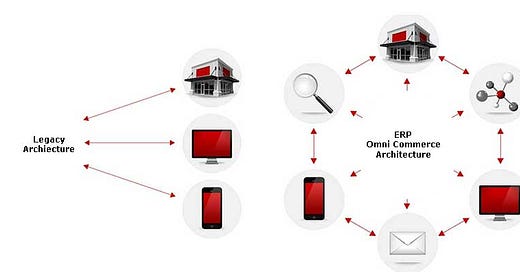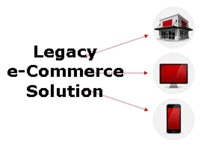Tariffs, Artificial Intelligence, blockchain, and economic turmoil are driving CIOs away from e-commerce to OmniCommerce
Evolution of the marketplace from Brick and Mortar to OminCommerce
The marketplace is changing, and CIOs are being driven towards OmniCommerce solutions. The primary drivers are a desire for enhanced brand consistency, increased sales and traffic, enhanced customer experience, improved customer loyalty, advanced data collection, streamlined operations, and increased competitive advantage.
A single channel solution (pre-2000) where the enterprise is selling a product or service via a single sales channel – a brick and mortar store, a website, or an online marketplace like Amazon or eBay. This can work perfectly well. But, if you want to give your customers a richer experience with your brand, look to expand the channels where you can sell your product.
A multichannel solution (2000-2020) sells a product or service to its customers on multiple channels, both online and offline (e-commerce). The enterprise interacts with its customers via social media, by phone, and in its physical store. The online presence is on point, and customers know where to find the enterprise’s products and services. Multichannel is already a great strategy to get people engaging with your brand.
An OmniCommerce solution (2020 – Future) takes place on multiple channels too, like the multichannel commerce strategy. Without multichannel, there's no omnichannel. The big difference is that omnichannel commerce connects all channels. This means your customer has a seamless experience across all platforms. Tariff structure, economic environment, AI, blockchain, and the changing economic structure are driving CIOs to implement this solution.
OmniCommerce Strategy
An OmniCommerce Strategy requires a redefinition that includes Enterprise Resource Planning (ERP) a robust governance strategy that takes advantage of all of the necessary policies and procedures to meet the enterprise’s objectives. This includes new technologies of social networking, connectivity to a full range of internet-capable devices, blockchain architecture, and artificial intelligence.
Roles need to be defined for key players. To understand the scope of this, all of the IT and business professionals involved should be identified. As a first step, a CIO should review the roles and responsibilities of all of the IT professionals in the process. Then the CIO should have a partnership with the operations team. Some of the IT positions the CIO should address are:
Chief Artificial Intelligence Officer (CAIO)
Chief Experience Officer (CXO)
Digital Brand Manager
Director e-Commerce
Manager Blockchain Architecture
Manager Disaster Recovery and Business Continuity
Manager Internet Systems
Manager Point of Sale
Manager Record Administration
Manager Security and Workstations
Manager Transaction Processing
Manager Video and Website Content
Manager Wireless Systems
e-Commerce Coordinator
PCI-DSS Administrator
Record Management Coordinator
SEO Specialist
System Administrator – Linux
System Administrator - UNIX
System Administrator – Windows
Web Analyst
Website Designer
Webmaster
Wi-Fi Network Administrator
While the roles of these individuals are being defined, the overall organizational infrastructure should be updated to address the issues raised by OmniCommerce. The policies that should be reviewed include:
Backup and Backup Retention Policy
Blog and Personal Web Site Policy
BYOD Policy Template
Google Glass Policy
Incident Communication Plan Policy
Internet, e-Mail, Social Networking, Mobile Device, Electronic Communications, and Record Retention Policy
Mobile Device Access and Use Policy
Outsourcing and Cloud-Based File Sharing Policy
Patch Management Policy
Physical and Virtual Server Security Policy
Privacy Compliance Policy - California Privacy Act
Record Classification, Management, Retention, and Destruction Policy
Safety Program
Subscribers save 50% on Janco’s OmniCommerce Strategy Bundle
Keep reading with a 7-day free trial
Subscribe to CIO and IT Management Newsletter to keep reading this post and get 7 days of free access to the full post archives.






